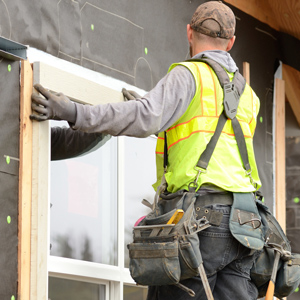
As 2021 draws to a close, it’s natural to wonder what the New Year may bring. For the fenestration and glazing industry, 2022 could mean new opportunities as a result of a $1.2 trillion Infrastructure and Investment Jobs Act signed into law as Public Law 117-58 in the U.S. on November 15.
The new law includes a $550 million appropriation in Energy Efficiency and Conservation Block Grant funding and $500 million in State Energy Program funding for state and local governments to adopt and implement building energy codes. Another $225 million is targeted for the U.S. Department of Energy (DOE) to award grants to implement building codes.
The infrastructure law also calls for investing $3.5 billion in the Weatherization Assistance Program, to increase energy efficiency and reduce energy costs for low-income households in the U.S. Plus, there’s $500 million earmarked for energy efficiency and renewable energy improvements to be funded by the federal government at public school facilities.
Could this influx of federal funding drive more opportunities for high-performance glazing, windows, doors and skylights and the components used in them? Time will tell.
Prior to signing the infrastructure bill into law, President Biden also signed Executive Order 14052 with the force of law, November 15. The Order directs federal officials making purchasing decisions that materials made in the United States be given priority in federally-funded infrastructure projects. Specifically, one of the Order’s priorities is to “Buy American and increase the competitiveness of the U.S. economy, including through implementing the Act’s Made-In-America requirements and bolstering domestic manufacturing and supply chains.”
Executive Order 14052 also calls for “improving job opportunities for millions of Americans by focusing on high labor standards for these jobs, including prevailing wages and the free and fair chance to join a union.” The infrastructure law also requires “all construction workers on projects funded by the deal to be paid prevailing wages, according to the Davis-Bacon Act.”
So what else is in the new law? And what comes to mind when you first hear the word infrastructure? Often, it’s roads and bridges. Of the more than $1 trillion infrastructure federal spending package, $110 billion is earmarked for upgrading America’s roads and bridges. Since many fenestration products and components used in them are often shipped by truck, the prospect of building and maintaining smoother, safer roads and bridges is welcome news.
Another $25 billion in new spending is targeted for upgrades and expansions to U.S. airports, control towers and control systems, plus decreasing emissions near airports. About $17 billion in new money is slated for updating America’s aging port infrastructure and limiting truck emissions at ports.
The infrastructure package also allocates $65 billion into expanding broadband service in the U.S., to speed and improve infrastructure access, especially in rural areas or low-income communities. This will help support remote work, as increasingly, Americans choose to live and work in less populated or less costly to live areas, where improved broadband service will help support workforce growth and improved communications infrastructure.
The new legislation also aims to address the U.S. labor shortage by funding training programs, potentially helping the fenestration and glazing industries net new, recently trained laborers for the workforce.
In addition, the infrastructure law allocates $65 billion for upgrading America’s electrical grid, including beefing up electric transmission lines and incentivizing wind and solar energy generation investments.
As 2022 draws to a close, the U.S. faces 30-year high inflation rates driving up the cost for goods and services, higher energy costs for heating homes and businesses and filling up at the gas pump, ongoing supply chain strains, challenges in attracting and retaining skilled labor and the continued COVID-19 pandemic.
However, there are still many things for which to feel thankful. Personally, am grateful for the strong support shown by FGIA members in the U.S. and Canada, and other countries, and for all that our loyal, dedicated members do by working together through FGIA to drive our organization’s and the industry’s success. Here’s to continued success and achieving excellence in the New Year!



